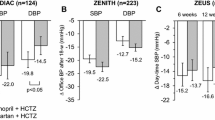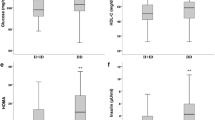Abstract
Background and Objective: Renin-angiotensin system (RAS) inhibitors, such as angiotensin-converting enzyme (ACE) inhibitors and angiotensin II type 1 receptor antagonists (angiotensin receptor blockers [ARBs]), are recommended by the American Diabetes Association for blood pressure control and prevention or management of cardiovascular disease in patients with diabetes mellitus. However, some investigators have suggested that ARBs may increase the risk of myocardial infarction in hypertensive patients. Activation of the RAS is associated with an increased risk of ischaemic events. Angiotensin II stimulates the production of plasminogen activator inhibitor type-1 (PAI-1), a powerful predictor of cardiovascular disease. ACE inhibitors are reported to reduce PAI-1 levels and activity, while ARBs do not reduce or may even elevate levels of this atherogenic marker. The objective of this study was to determine whether the ACE inhibitor imidapril reduces PAI-1 levels in hypertensive patients already being treated with an ARB.
Methods: This was a prospective cohort study carried out in primary care with a follow-up period of 6 months. Estimating the α error (p-value) at 0.05, the power of the test as 80%, and the difference in PAI-1 levels as 10 ±15ng/mL, the required sample size was calculated to be 40. Participants were hypertensive patients taking ARBs for more than 8 weeks, and having dyslipidaemia, obesity or abnormal glucose metabolism. Imidapril 5–10 mg/day was prescribed for 6 months to reduce blood pressure to < 130/80 mmHg. The main outcome measure, PAI-1 level, was measured before and 6 months after the addition of imidapril to ARBs in 21 subjects (13 men, eight women), all with abnormal glucose metabolism, nine with dyslipidaemia, and six who were obese. Bodyweight, body mass index, blood pressure, homeostasis model assessment of insulin resistance, glycosylated haemoglobin, creatinine, potassium, high sensitivity C-reactive protein (hs-CRP), and high molecular weight adiponectin levels were measured as secondary outcomes.
Results: PAI-1 level was not significantly changed overall. Hs-CRP level was also not significantly changed; however, the high molecular weight adiponectin level was significantly increased (p = 0.044), especially in men (p = 0.026). There were no significant changes in the other outcomes measured.
Conclusion: The current study showed that imidapril added to ARBs did not decrease PAI-1 levels in hypertensive patients with abnormal glucose metabolism; however, this combination therapy significantly increased high molecular weight adiponectin levels in men.




Similar content being viewed by others
References
American Diabetes Association. Standards of medical care in diabetes. Diabetes Care 2008; 31Suppl. 1: S12–54
Verma S, Strauss M. Angiotensin receptor blockers and myocardial infarction. BMJ 2004; 329: 1248–9
Cheung BM, Cheung GT, Lauder IJ, et al. Meta-analysis of large outcome trials of angiotensin receptor blockers in hypertension. J Hum Hypertens 2006; 20: 37–43
Verdecchia P, Angeli F, Gattobigio R, et al. Do angiotensin II receptor blockers increase the risk of myocardial infarction? Eur Heart J 2005; 26: 2381–6
McDonald MA, Simpson SH, Ezekowitz JA, et al. Angiotensin receptor blockers and risk of myocardial infarction: systematic review. BMJ 2005; 331: 873
Volpe M, Mancia G, Trimarco B. Angiotensin II receptor blockers and myocardial infarction: deeds and misdeeds. J Hypertens 2005; 23: 2113–8
Tsuyuki RT, McDonald MA. Angiotensin receptor blockers do not increase risk of myocardial infarction. Circulation 2006; 114: 855–60
The CONSENSUS Trial Study Group. Effects of enalapril on mortality in severe congestive heart failure: results of the Cooperative North Scandinavian Enalapril Survival Study (CONSENSUS). N Engl J Med 1987; 316: 1429–35
Cohn JN, Johnson G, Ziesche S, et al. A comparison of enalapril with hydralazine-isosorbide dinitrate in the treatment of chronic congestive heart failure. N Engl J Med 1991; 325: 303–10
The SOLVD Investigators. Effect of enalapril on mortality and the development of heart failure in asymptomatic patients with reduced left ventricular ejection fractions. N Engl J Med 1992; 327: 685–91
Yusuf S, Sleight P, Pogue J, et al. Effects of an angiotensin-converting-enzyme inhibitor, ramipril, on cardiovascular events in high-risk patients. The Heart Outcomes Prevention Evaluation Study Investigators. N Engl J Med 2000; 342: 145–53
Sleight P, Yusuf S, Pogue J, et al. Blood-pressure reduction and cardiovascular risk in HOPE study. Lancet 2001; 358: 2130–1
Epstein BJ, Gums JG. Angiotensin receptor blockers versus ACE inhibitors: prevention of death and myocardial infarction in high-risk populations. Ann Pharmacother 2005; 39: 470–80
Turnbull F, Neal B, Pfeffer M, et al. Blood pressure-dependent and independent effects of agents that inhibit the renin-angiotensin system. J Hypertens 2007; 25: 951–8
Strauss MH, Hall AS. Angiotensin receptor blockers may increase risk of myocardial infarction: unraveling the ARB-MI paradox. Circulation 2006; 114: 838–54
Ridker PM, Vaughan DE, Stampfer MJ, et al. Endogenous tissue-type plasminogen activator and risk of myocardial infarction. Lancet 1993; 341: 1165–8
Ridker PM, Hennekens CH, Stampfer MJ, et al. Prospective study of endogenous tissue plasminogen activator and risk of stroke. Lancet 1994; 343: 940–3
Thompson SG, Kienast J, Pyke SD, et al. Hemostatic factors and the risk of myocardial infarction or sudden death in patients with angina pectoris. European Concerted Action on Thrombosis and Disabilities Angina Pectoris Study Group. N Engl J Med 1995; 332: 635–41
Salomaa V, Stinson V, Kark JD, et al. Association of fibrinolytic parameters with early atherosclerosis. The ARIC Study: Atherosclerosis Risk in Communities Study. Circulation 1995; 91: 284–90
Collet JP, Montalescot G, Vicaut E, et al. Acute release of plasminogen activator inhibitor-1 in ST-segment elevation myocardial infarction predicts mortality. Circulation 2003; 108: 391–4
Alderman MH, Madhavan S, Ooi WL, et al. Association of the renin-sodium profile with the risk of myocardial infarction in patients with hypertension. N Engl J Med 1991; 324: 1098–104
Vaughan DE, Lazos SA, Tong K. Angiotensin II regulates the expression of plasminogen activator inhibitor-1 in cultured endothelial cells: a potential link between the renin-angiotensin system and thrombosis. J Clin Invest 1995; 95: 995–1001
Brown NJ, Agirbasli M, Vaughan DE. Comparative effect of angiotensin-converting enzyme inhibition and angiotensin II type 1 receptor antagonism on plasma fibrinolytic balance in humans. Hypertension 1999; 34: 285–90
Kohler HP, Grant PJ. Plasminogen-activator inhibitor type 1 and coronary artery disease. N Engl J Med 2000; 342: 1792–801
Brown NJ, Kumar S, Painter CA, et al. ACE inhibition versus angiotensin type 1 receptor antagonism: differential effects on PAI-1 over time. Hypertension 2002; 40: 859–65
Okada H, Watanabe Y, Kikuta T, et al. Bradykinin decreases plasminogen activator inhibitor-1 expression and facilitates matrix degradation in the renal tubulointerstitium under angiotensin-converting enzyme blockade. J Am Soc Nephrol 2004; 15: 2404–13
Vandenburg MJ, Mackay EM, Dews I, et al. Dose finding studies with imidapril: a new ACE inhibitor. Br J Clin Pharmacol 1994; 37: 265–72
van Veldhuisen DJ, Genth-Zotz S, Brouwer J, et al. High-versus low-dose ACE inhibition in chronic heart failure: a double-blind, placebo-controlled study of imidapril. J Am Coll Cardiol 1998; 32: 1811–8
Katayama S, Kikkawa R, Isogai S, et al. Effect of captopril or imidapril on the progression of diabetic nephropathy in Japanese with type 1 diabetes mellitus: a randomized controlled study (JAPAN-IDDM). Diabetes Res Clin Pract 2002; 55: 113–21
Saruta T, Omae T, Kuramochi M, et al. Imidapril hydrochloride in essential hypertension: a double-blind comparative study using enalapril maleate as a control. J Hypertens 1995 Sep; 13Suppl. 3: S23–30
Matthews DR, Hosker JP, Rudenski AS, et al. Homeostasis model assessment: insulin resistance and beta-cell function from fasting plasma glucose and insulin concentrations in man. Diabetologia 1985; 28: 412–9
Kluft C, Jie AF, Rijken DC, et al. Daytime fluctuations in blood of tissue-type plasminogen activator (t-PA) and its fast-acting inhibitor (PAI-1). Thromb Haemost 1988; 59: 329–32
Fogari R, Zoppi A, Preti P, et al. Differential effects of ACE-inhibition and angiotensin II antagonism on fibrinolysis and insulin sensitivity in hypertensive postmenopausal women. Am J Hypertens 2001; 14: 921–6
Fogari R, Mugellini A, Zoppi A, et al. Losartan and perin-dopril effects on plasma plasminogen activator inhibitor-1 and fibrinogen in hypertensive type 2 diabetic patients. Am J Hypertens 2002; 15: 316–20
Kerins DM, Hao Q, Vaughan DE. Angiotensin induction of PAI-1 expression in endothelial cells is mediated by the hexapeptide angiotensin IV. J Clin Invest 1995; 96: 2515–20
Prasad K. C-reactive protein (CRP)-lowering agents. Cardiovasc Drug Rev 2006; 24: 33–50
Di Napoli M, Papa F. Angiotensin-converting enzyme inhibitor use is associated with reduced plasma concentration of C-reactive protein in patients with first-ever ischemic stroke. Stroke 2003; 34: 2922–9
Koulouris S, Symeonides P, Triantafyllou K, et al. Comparison of the effects of ramipril versus telmisartan in reducing serum levels of high-sensitivity C-reactive protein and oxidized low-density lipoprotein cholesterol in patients with type 2 diabetes mellitus. Am J Cardiol 2005; 95:1386–8
Pearson TA, Mensah GA, Alexander RW, et al. Markers of inflammation and cardiovascular disease: application to clinical and public health practice. A statement for healthcare professionals from the Centers for Disease Control and Prevention and the American Heart Association. Circulation 2003; 107: 499–511
Ridker PM, Cook N. Clinical usefulness of very high and very low levels of C-reactive protein across the full range of Framingham Risk Scores. Circulation 2004; 109: 1955–9
Ikonomidis I, Stamatelopoulos K, Lekakis J, et al. Inflammatory and non-invasive vascular markers: the multimarker approach for risk stratification in coronary artery disease. Atherosclerosis 2008; 199: 3–11
Matsuzawa Y, Funahashi T, Kihara S, et al. Adiponectin and metabolic syndrome. Arterioscler Thromb Vasc Biol 2004; 24: 29–33
Lara-Castro C, Luo N, Wallace P, et al. Adiponectin multimeric complexes and the metabolic syndrome trait cluster. Diabetes 2006; 55: 249–59
Pischon T, Girman CJ, Hotamisligil GS, et al. Plasma adiponectin levels and risk of myocardial infarction in men. JAMA 2004; 91: 1730–7
Furuhashi M, Ura N, Higashiura K, et al. Blockade of the renin-angiotensin system increases adiponectin concentrations in patients with essential hypertension. Hypertension 2003; 42: 76–81
Nomura S, Shouzu A, Omoto S, et al. Effect of valsartan on monocyte/endothelial cell activation markers and adiponectin in hypertensive patients with type 2 diabetes mellitus. Thromb Res 2006; 117: 385–92
McKelvie RS, Yusuf S, Pericak D, et al. Comparison of candesartan, enalapril, and their combination in congestive heart failure: randomized evaluation of strategies for left ventricular dysfunction (RESOLVD) pilot study. The RESOLVD Pilot Study Investigators. Circulation 1999; 100: 1056–64
Cohn JN, Tognoni G. A randomized trial of the angiotensin-receptor blocker valsartan in chronic heart failure. N Engl J Med 2001; 345: 1667–75
McMurray JJ, Ostergren J, Swedberg K, et al. Effects of candesartan in patients with chronic heart failure and reduced left-ventricular systolic function taking angiotensin-converting-enzyme inhibitors: the CHARM-Added trial. Lancet 2003; 362: 767–71
McMurray J, Solomon S, Pieper K, et al. The effect of valsartan, captopril, or both on atherosclerotic events after acute myocardial infarction: an analysis of the Valsartan in Acute Myocardial Infarction Trial (VALIANT). J Am Coll Cardiol 2006; 47: 726–33
Lee VC, Rhew DC, Dylan M, et al. Meta-analysis: angiotensin-receptor blockers in chronic heart failure and high-risk acute myocardial infarction. Ann Intern Med 2004; 141: 693–704
Nakao N, Yoshimura A, Morita H, et al. Combination treatment of angiotensin-II receptor blocker and angio-tensin-converting-enzyme inhibitor in non-diabetic renal disease (COOPERATE): a randomised controlled trial. Lancet 2003; 361: 117–24
Jennings DL, Kalus JS, Coleman CI, et al. Combination therapy with an ACE inhibitor and an angiotensin receptor blocker for diabetic nephropathy: a meta-analysis. Diabet Med 2007; 24: 486–93
Phillips CO, Kashani A, Ko DK, et al. Adverse effects of combination angiotensin II receptor blockers plus angiotensin-converting enzyme inhibitors for left ventricular dysfunction: a quantitative review of data from randomized clinical trials. Arch Intern Med 2007; 167: 1930–6
ONTARGET Investigators. Telmisartan, ramipril, or both in patients at high risk for vascular events. N Engl J Med 2008; 358: 1547–59
Acknowledgements
No sources of funding were used to assist in the preparation of this study. The authors have no conflicts of interest that are directly relevant to the content of this study.
Author information
Authors and Affiliations
Corresponding author
Rights and permissions
About this article
Cite this article
Yajima, K., Shimada, A., Hirose, H. et al. Effect on the Atherogenic Marker Plasminogen Activator Inhibitor Type-1 of Addition of the ACE Inhibitor Imidapril to Angiotensin II Type 1 Receptor Antagonist Therapy in Hypertensive Patients with Abnormal Glucose Metabolism. Clin. Drug Investig. 29, 811–819 (2009). https://doi.org/10.2165/11530610-000000000-00000
Published:
Issue Date:
DOI: https://doi.org/10.2165/11530610-000000000-00000




